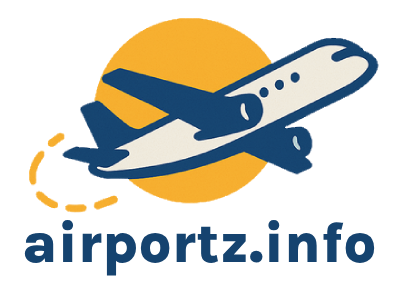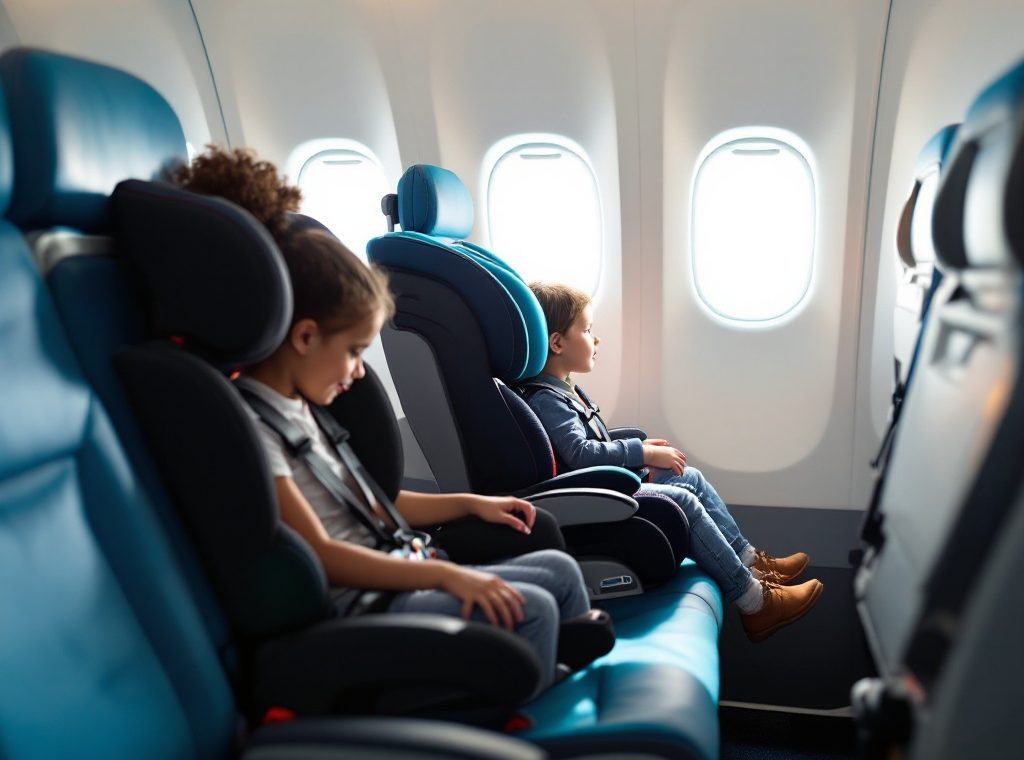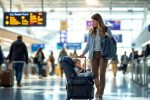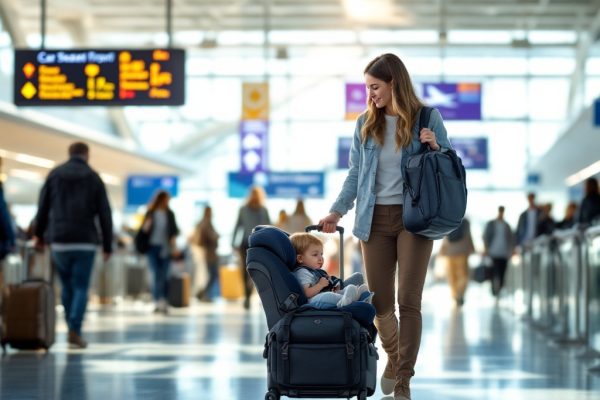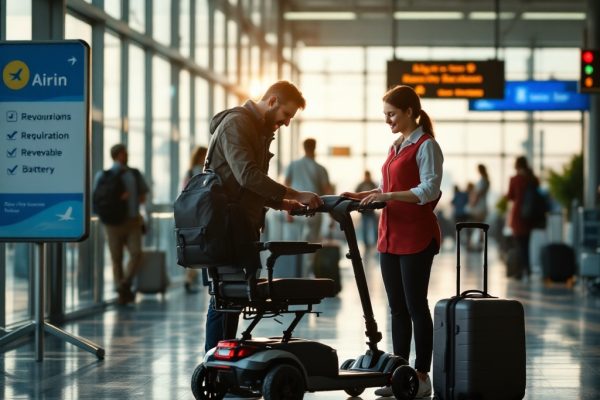Car Seats Approved for Air Travel: Ultimate Guide
Worried about your child’s safety and comfort during air travel? FAA-approved car seats offer significantly better protection than lap belts alone, especially during turbulence. These seats meet stringent aircraft safety standards, providing a secure and familiar environment for your child. From lightweight and portable options like the Cosco Scenera Next to convertible models like the Chicco KeyFit 35, discover the perfect car seat to make your next flight safer and more enjoyable. Learn how to choose the right FAA-approved car seat and ensure proper installation for a stress-free journey.
Important information

- Using an FAA-approved car seat significantly increases child safety during air travel, offering better protection than a lap belt, especially during turbulence.
- The car seat must have an FAA approval label, indicating it meets the necessary safety standards for both car and air travel.
- For airplane use, the car seat should be forward-facing and placed in a window seat (not an aisle or exit row seat), following airline policies.
- Lightweight and portable car seats, like the Cosco Scenera Next and Doona Infant Car Seat, are convenient for air travel but always verify FAA approval.
- A five-point harness system is a key safety feature, distributing crash forces across stronger body areas to minimize injury risk.
Introduction to Car Seats Approved for Air Travel
Approved car seats significantly enhance children’s safety during air travel. These seats undergo rigorous testing to meet stringent aircraft safety standards, providing crucial protection during turbulence and other unforeseen events. Look for the FAA approval label to ensure compliance. Various car seat types, including rear-facing, forward-facing, and booster seats, can be certified for aircraft use. Some models are designed for easy installation and lightweight portability, simplifying air travel with young children and providing added parental reassurance.
Importance of Car Seats on Planes
For a safer flight, the FAA recommends using car seats for children. Car seats offer significantly better protection than lap belts alone, keeping kids securely in place and minimizing movement, especially during turbulence. This enhanced stability reduces the risk of injury.
A familiar car seat can also add to a child’s comfort during the flight.
FAA Approval and Certification Requirements
When flying, your car seat must be certified for both car and air travel. Look for an FAA approval label, which confirms it meets the necessary safety standards for both uses. This dual certification ensures your child’s safety in both cars and airplanes.
Types of Travel Car Seats for Air Travel
Enhance your family’s flight safety by using approved car seats. Most car seats certified by the FAA are acceptable for air travel; simply look for the label. Ensure your seat faces forward in a window seat (aisle seats are not permitted). For convenient travel, explore lightweight, portable car seats. Infant, convertible, and booster seats are all welcome onboard, provided they have FAA approval.
Infant Car Seats
Infant car seats protect babies and toddlers during car rides and flights. They are designed for children weighing up to 30–35 pounds and measuring 30–32 inches tall. These rear-facing seats offer optimal protection for a child’s head, neck, and spine during a collision or turbulent flight. For air travel, using an FAA-approved car seat (look for the label) provides enhanced safety. Place the seat in a window seat to minimize contact with passing carts and other passengers.
Convertible Car Seats
Convertible car seats adapt to your growing child by offering both rear-facing and forward-facing positions. For air travel, however, the seat must be FAA-approved. Look for the label to ensure your child’s safety.
Booster Seats and Their Limitations
While booster seats aren’t FAA-approved for air travel, some airlines may permit their use for lap children. Always confirm your airline’s specific policy before your flight.
Lightweight and Portable Options
Traveling with young children can be stressful, but lightweight and portable car seats simplify air travel. Easy to install and meeting strict safety standards, models like the Cosco Scenera Next and the Doona Infant Car Seat are designed for effortless handling. Their compact design makes navigating busy airports and fitting into airplane seats a breeze. Rigorous testing ensures these seats perform safely, even under the specific demands of air travel, giving you peace of mind on your journey.
Benefits of Lightweight Car Seats for Air Travel
- easy to install,
- meet strict safety standards,
- designed for effortless handling.
Features of Lightweight Car Seats
- compact design for easy airport navigation,
- fits into airplane seats,
- rigorously tested for air travel safety.
Key Features of FAA-Approved Car Seats
Travel with peace of mind knowing your child is safe and secure with our lightweight, compact, and FAA-approved car seat. Designed for convenience, this car seat is easy to transport and airplane compatible. It’s clearly labeled to assure you it meets all necessary FAA standards. The five-point harness maximizes protection, and the straightforward installation process makes it easy to use in both cars and on planes. For added convenience, the car seat features removable, washable covers, keeping it clean and fresh for every journey. If you’re planning international travel, consider a car seat with European belt path compatibility for a smoother trip.
Proper Labels and Certification
Before installing a car seat on a plane, check for two important labels. One label certifies its approved use in motor vehicles and aircraft. The second label confirms compliance with Federal Motor Vehicle Safety Standard (FMVSS) 213. Ensure the car seat functions correctly before use.
Safety Ratings and Crash Testing
Car seat safety ratings are essential for parents, evaluating both crash test performance and ease of use. Crash tests simulate real-world accidents, assessing a seat’s protective capabilities in frontal, side, and rear impacts. Organizations like the NHTSA (National Highway Traffic Safety Administration) and IIHS (Insurance Institute for Highway Safety) conduct these rigorous tests, rating how effectively the car seat’s structure protects a child during a collision. Ease of use is another critical factor. Ratings consider installation simplicity, harness adjustment, and label clarity, ensuring that parents can use the seat correctly every time. Clear instructions and a well-designed harness are essential for optimal safety and proper installation. Therefore, consider both crash test results and user-friendliness when choosing a car seat to ensure your child’s safety.
Five-point Harness System
A five-point harness significantly enhances child safety in vehicles. Its straps, positioned at the shoulders, hips, and between the legs, distribute crash forces across the body’s stronger areas, like the pelvis and chest.
This strategic design minimizes injury risk by preventing concentrated force on vulnerable areas.
By securely holding the child, the harness proves particularly vital during sudden stops and crashes.
European Belt Path Compatibility
Some car seats offer a “European belt path,” allowing installation with an airplane lap belt. This provides a convenient alternative to a base or LATCH system, proving especially useful during flights, as airplanes often lack LATCH anchors. Check your car seat manual to confirm if it offers this feature.
Installation and Safety Guidelines for Airplane Use
Securely fasten your forward-facing car seat to the airplane seat using the airplane’s seatbelt. Route the seatbelt through the car seat’s belt path. Consult your car seat manufacturer’s instructions for specific guidance. Comply with airline policies. Ensure your car seat has the required FAA approval, typically indicated by a label on the seat.
Recommended Seat Placement
When flying with a child in a car seat, a window seat offers the best protection, especially during turbulence, shielding them from unexpected bumps. However, keep in mind that most airlines prohibit car seats in exit rows, as well as the rows immediately before and after. Always confirm your airline’s specific car seat policies, as they may have additional requirements.
Easy Installation Methods
Enhance your child’s safety during air travel by using a car seat. Ideally, secure the car seat in a window seat. Consult your car seat’s manual for airplane-specific instructions. Ensure your car seat is aircraft-approved. Use the airplane’s seatbelt to fasten the car seat securely.
Airline Policies and Regulations
Airline car seat policies differ depending on the aircraft. Many airlines offer free car seat check-in at the ticket counter, a convenient perk for travelers.
Top Travel Car Seat Recommendations
The Doona Infant Car Seat offers unparalleled travel convenience by seamlessly converting into a stroller.
Known for its easy installation and compatibility with numerous strollers, the Chicco KeyFit 35 is another excellent option.
The Cosco Finale 2-in-1 booster seat adapts to your child’s growth, functioning both with and without a back.
For a budget-friendly and lightweight option, especially for air travel, the Cosco Scenera Next is a popular choice.
Alternatively, the Cosco Rise LX convertible car seat offers multiple recline positions and higher weight limits, providing flexibility for various travel scenarios.
Doona Infant Car Seat
Traveling with a baby can be challenging, but the Doona infant car seat provides a streamlined solution. FAA-approved for air travel, it effortlessly converts from car seat to stroller, simplifying travel for parents. This eliminates the need for separate equipment, offering both unparalleled convenience and peace of mind.
Cosco Scenera Next
The lightweight Cosco Scenera Next car seat is FAA-approved, making air travel with young children easier. Its compact design simplifies transport through airports and accommodates children weighing 5 to 40 pounds.
Chicco KeyFit 35
The Chicco KeyFit 35 infant car seat offers safety and convenience for air and road travel, accommodating infants from 4 to 35 pounds and up to 30 inches tall. Its FAA approval ensures safe flights. The five-point harness and energy-absorbing foam provide enhanced protection on the road. Installation is simplified with the ReclineSure leveling foot and RideRight bubble level indicators. The KeyFit 35’s compatibility with Chicco strollers creates a versatile travel system, allowing easy transfer of your baby between car and stroller.
Cosco Finale 2-in-1
The Cosco Finale 2-in-1 car seat adapts to your child’s growth, offering forward-facing versatility. Suitable for children weighing 22-65 pounds, it starts as a harnessed booster, then transitions seamlessly to a belt-positioning booster for children 40-100 pounds. Its lightweight frame simplifies travel, making it easy to maneuver through airports. Plus, it’s FAA-approved for aircraft use. For added safety and peace of mind, the Finale features a secure five-point harness.
Cosco Rise LX
The Cosco Rise LX booster car seat offers excellent value for budget-conscious families. Perfect for everyday car trips, it is also lightweight and portable enough for air travel. However, be sure to check with your airline, as it lacks FAA approval.
Enhancing Travel with Car Seats
Traveling with young children can be stressful, but using an FAA-approved car seat can significantly improve the experience. These seats enhance in-flight safety and provide comfort, giving parents peace of mind knowing their children are secure. The familiar car seat can also create a sense of routine, reducing anxiety and promoting better sleep. Additionally, it protects the child from turbulence and unexpected movements. Even airport transfers become smoother since the child is already accustomed to their car seat. Using an FAA-approved car seat offers several benefits:
- enhanced in-flight safety and comfort,
- reduced anxiety and better sleep for children,
- protection from turbulence and unexpected movements,
- smoother airport transfers.
Benefits of FAA-approved Car Seats
FAA-approved car seats significantly enhance children’s safety during air travel. Meeting stringent FAA standards, these seats are designed to withstand turbulence and unforeseen events, providing superior protection compared to holding a child on one’s lap. This added security significantly reduces the risk of injury.
Moreover, the familiar environment of a car seat can comfort anxious young flyers. The increased comfort and support, particularly on longer journeys, promote better sleep. Ultimately, using an approved car seat offers substantial advantages for the safety and well-being of children during flight.
Ensuring Comfort and Safety for Young Children
Approved car seats significantly improve both the safety and comfort of children during air travel. Proper installation, in accordance with airline guidelines, is essential for maximizing the seat’s protective capabilities in turbulence and other unexpected events. A correctly installed seat provides a familiar and reassuring environment for the child, reducing anxiety and promoting better sleep due to its superior support compared to a lap belt. This ultimately contributes to a smoother, more relaxed travel experience for the entire family.
